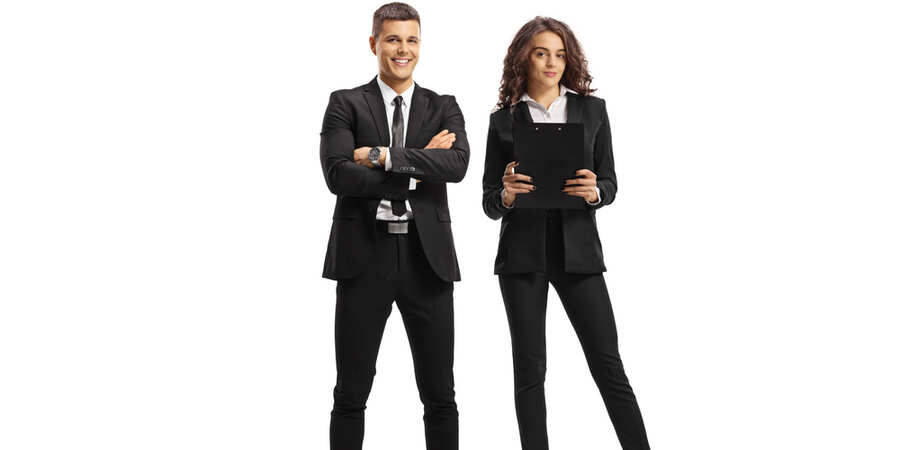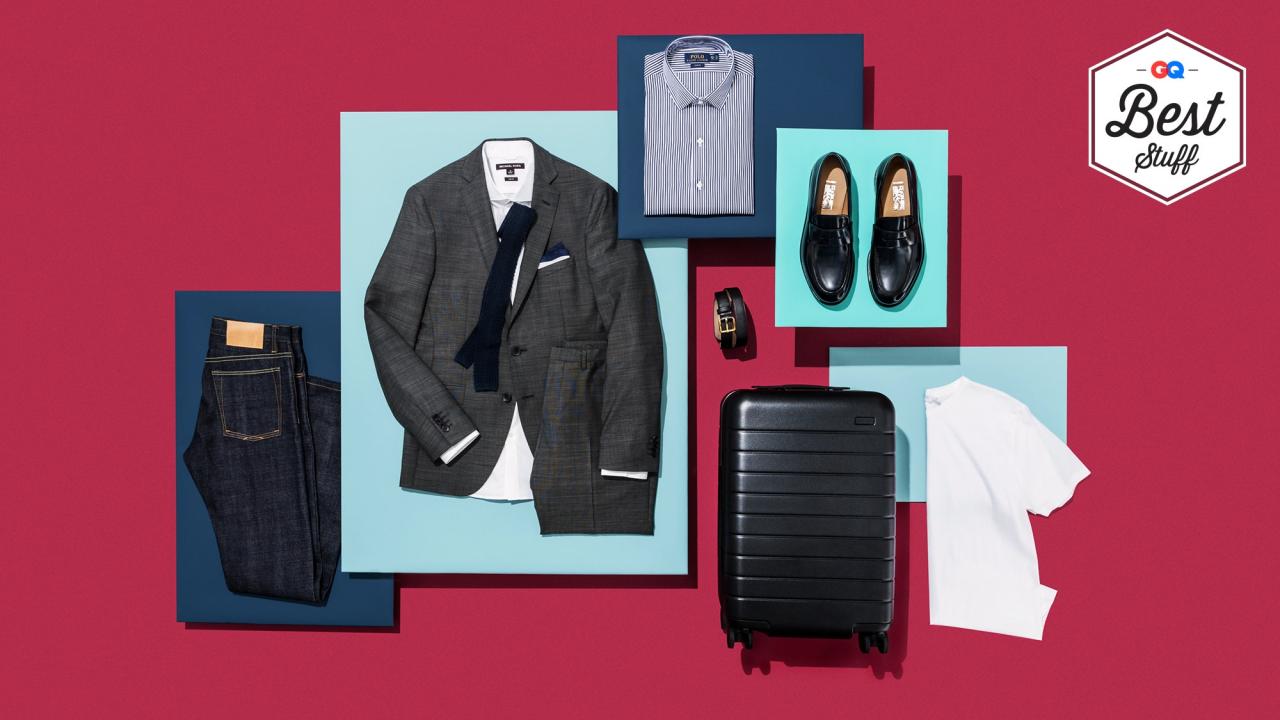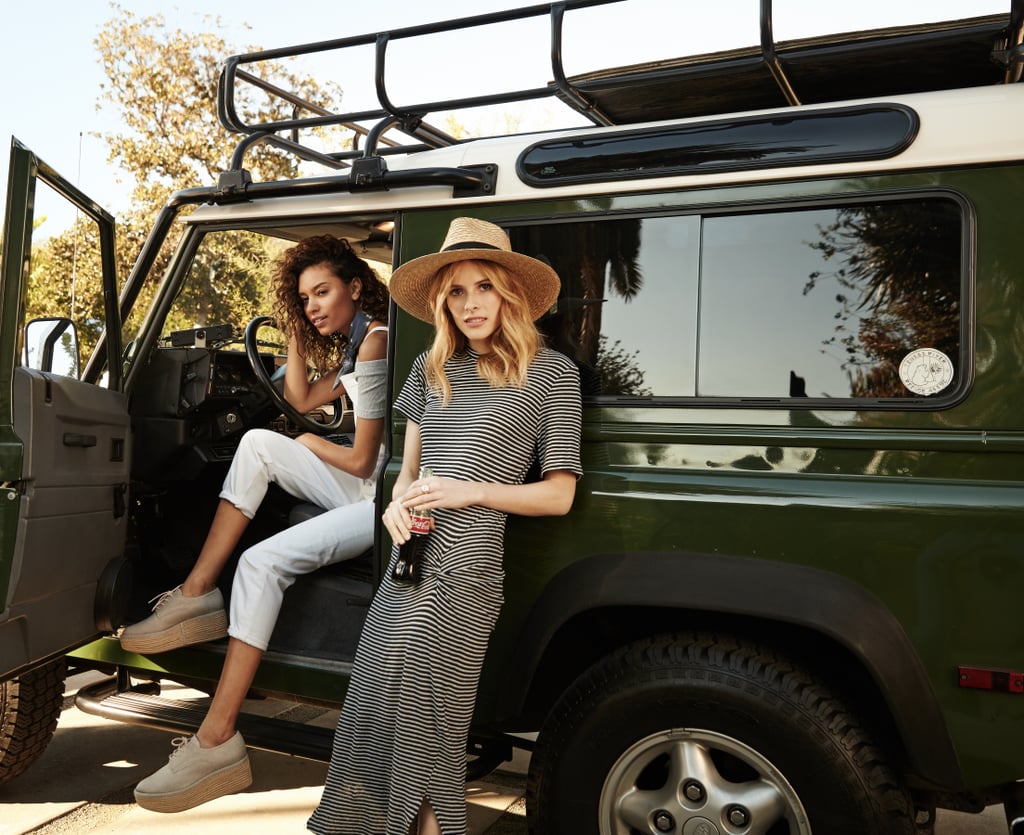What to wear on a business trip? This seemingly simple question can spark significant pre-trip anxiety. Successfully navigating professional attire across various contexts—from boardroom meetings to casual networking events—requires careful planning and a strategic approach to packing. This guide provides a comprehensive framework, covering everything from essential packing lists and understanding diverse dress codes to mastering weather adaptability and maintaining comfort during travel. We’ll explore versatile outfit combinations, practical tips for minimizing wrinkles and maximizing space, and even offer visual inspiration to help you confidently conquer your next business trip.
From choosing the right fabrics for different climates to understanding the nuances of business formal, business casual, and smart casual attire, we’ll equip you with the knowledge to make informed decisions. We’ll also cover essential travel considerations like comfortable footwear and maintaining personal hygiene while on the go. Ultimately, the goal is to ensure you present a polished and professional image while feeling comfortable and confident throughout your journey.
Packing Essentials for a Business Trip

A well-planned packing strategy is crucial for a successful business trip. Efficient packing minimizes stress, ensures you’re prepared for any eventuality, and allows you to arrive looking professional and confident. This section details essential items and strategies for optimizing your packing process.
Clothing Item Selection and Packing List
Creating a comprehensive packing list is the first step to efficient packing. Consider the length of your trip, the climate of your destination, and the nature of your business engagements when selecting items. The following table provides a structured approach:
| Clothing Category | Item Suggestions | Quantity | Notes |
|---|---|---|---|
| Suits | Navy or charcoal suit, possibly a lighter-colored suit for warmer climates | 1-2 | Choose wrinkle-resistant fabrics. |
| Shirts/Blouses | Dress shirts (long and short-sleeved), blouses | 3-5 | Select versatile colors that coordinate with your suits and pants. |
| Pants/Skirts | Dress pants (at least one pair), skirt (optional, depending on dress code) | 2-3 | Consider wrinkle-resistant fabrics and dark neutral colors. |
| Dresses | A simple, elegant dress (optional, depending on context) | 0-1 | Suitable for some business dinners or less formal events. |
| Shoes | Dress shoes (loafers, oxfords, heels), comfortable walking shoes | 2 pairs | Ensure shoes are clean and polished. |
| Accessories | Belts, ties, scarves, jewelry (minimal and professional), quality socks and underwear | As needed | Accessories can add a touch of personality while maintaining professionalism. |
Fabric Selection Based on Climate and Business Context
Fabric choice significantly impacts comfort and appearance. For warm climates, opt for lightweight, breathable fabrics like linen or cotton blends. In cooler climates, wool or cashmere offer warmth and sophistication. Always prioritize wrinkle-resistant fabrics to minimize ironing needs while traveling. For business contexts, generally avoid overly casual fabrics like denim or brightly colored patterns in favor of more subdued and professional materials.
Maximizing Versatility Through Mix-and-Match Items
Packing versatile items is key to maximizing your wardrobe’s potential. Choose neutral-colored clothing items (black, navy, gray, beige) that can be easily mixed and matched to create multiple outfits. For example, a navy suit can be paired with different shirts and blouses, creating several different looks. A versatile dress can also be dressed up or down with accessories. This strategy significantly reduces the number of items you need to pack while maintaining a professional appearance.
Space-Saving and Wrinkle-Minimizing Packing Strategies
Efficient packing minimizes wrinkles and maximizes space. Rolling your clothes instead of folding them reduces wrinkles and saves space. Consider using packing cubes to organize your clothing and compress items. Place heavier items at the bottom of your suitcase and use delicate items as fillers in empty spaces. A garment bag can help to protect suits and dresses from wrinkles, ensuring they arrive looking their best. For shoes, consider using shoe bags to prevent them from dirtying your clothes.
Business Attire: What To Wear On A Business Trip
Navigating the complexities of business attire is crucial for making a positive professional impression. Understanding dress codes, both explicit and implicit, is essential for projecting confidence and competence in various business settings. This section will provide guidance on interpreting and adhering to appropriate business attire across different industries and contexts.
Business Attire Across Industries
The appropriate level of formality in business attire varies significantly depending on the industry. While some industries maintain a more traditional approach, others embrace a more relaxed style. Understanding these nuances is key to presenting yourself professionally within your specific field.
- Finance: Finance typically adheres to a more formal dress code. Suits (typically dark-colored) are common, along with polished shoes, and conservative accessories. Women might opt for tailored pantsuits or skirt suits. The overall impression should be one of sophistication and trustworthiness.
- Technology: The tech industry often boasts a more casual dress code, although this can vary greatly depending on the company and the specific role. Business casual, characterized by khakis or chinos, button-down shirts or blouses, and sweaters, is frequently acceptable. However, it’s important to gauge the specific company culture before making assumptions.
- Consulting: Consulting firms generally favor business professional or business casual attire, depending on client meetings and internal culture. While suits might be necessary for client presentations, internal meetings may allow for a more relaxed approach, such as tailored trousers or a skirt with a blouse and blazer.
- Law: The legal profession typically demands a more formal approach. Suits are the standard, and attention to detail in grooming and accessories is essential. Conservative colors and styles are generally preferred.
Understanding Unspoken Dress Codes
Beyond explicitly stated dress codes, many workplaces operate with unspoken expectations regarding appropriate attire. These often reflect the company’s overall culture and the context of the meeting or event. Observing colleagues and senior management can provide valuable insights into these unspoken rules. For instance, a company with a relaxed, creative atmosphere might tolerate more casual attire than a firm known for its traditional and conservative values. Similarly, a high-stakes client meeting would generally call for more formal attire than an internal brainstorming session.
Business Formal, Business Casual, and Smart Casual Attire
Three key categories define the spectrum of business attire:
- Business Formal: This is the most formal level of business attire. It typically includes a suit (dark-colored for men, navy, black, or grey for women), a collared shirt or blouse, a tie (for men), and polished, closed-toe shoes. Accessories should be minimal and professional.
- Business Casual: Business casual offers more flexibility. Acceptable options include khakis or dress pants, button-down shirts or blouses, sweaters, and loafers or dress shoes. The overall impression should be neat, professional, and appropriate for a business environment. Avoid jeans, t-shirts, and sneakers.
- Smart Casual: Smart casual is a step less formal than business casual. It allows for slightly more relaxed options, such as dark-wash jeans (in good condition), a blazer or cardigan, and clean, presentable shoes. However, it’s crucial to maintain a polished and professional appearance.
The Impact of Accessories on Professional Appearance, What to wear on a business trip
Accessories play a subtle yet significant role in shaping your overall professional image. They can enhance or detract from your appearance depending on the choices made.
- Watches: A simple, quality watch can add a touch of sophistication and professionalism.
- Jewelry: Keep jewelry minimal and understated. Avoid flashy or distracting pieces.
- Belts and Shoes: Ensure your belt and shoes are in good condition and match in color and style. Well-maintained shoes are crucial.
- Bags: A professional-looking briefcase or tote bag is essential for carrying documents and other necessary items.
Weather Considerations and Adaptability

Business trips often involve unpredictable weather, demanding adaptability in your packing strategy. Failing to account for diverse climates can lead to discomfort and hinder your productivity. Careful planning, however, ensures you’re prepared for any eventuality, maintaining professionalism and comfort throughout your journey.
Packing for Different Weather Conditions
Effective packing begins with anticipating the weather at your destination. Researching the forecast before your trip is crucial. The following table Artikels suitable clothing choices for hot, cold, and rainy conditions:
| Weather Condition | Clothing Choices |
|---|---|
| Hot | Lightweight breathable fabrics (linen, cotton), loose-fitting shirts and pants, shorts, sandals, a light jacket or shawl for air-conditioned spaces. |
| Cold | Layers of thermal underwear, sweaters, fleece jackets, a warm coat, waterproof boots, a scarf, gloves, and a hat. |
| Rainy | Waterproof jacket and trousers, waterproof shoes or boots, an umbrella, quick-drying clothing layers. |
Layering Clothing for Temperature Fluctuations
Layering is key to adapting to changing temperatures. Start with a base layer of thermal underwear or moisture-wicking fabric to regulate body temperature. Add a mid-layer such as a sweater or fleece jacket for insulation. Finally, a waterproof and windproof outer layer provides protection from the elements. This system allows you to easily adjust your clothing based on the temperature, removing layers when it’s warm and adding them when it gets colder. For example, a business traveler flying from a cold city to a warmer climate might wear thermal underwear and a sweater on the plane, then remove the sweater once they arrive at their destination.
Packing Light While Accommodating Weather Changes
Packing light for a business trip while accounting for weather variability requires strategic choices. Choose versatile clothing items that can be mixed and matched to create different outfits. Darker colors tend to hide wrinkles better than lighter colors. Consider wrinkle-resistant fabrics that minimize the need for ironing. Utilize packing cubes to compress your clothing and maximize space in your luggage. Prioritize essential items and eliminate duplicates. For instance, instead of packing several pairs of pants, select two pairs in neutral colors that can be paired with various shirts and blouses.
Essential Weather Protection Accessories
Accessories play a crucial role in weather protection. A high-quality umbrella provides shelter from rain, while a scarf offers warmth and can be styled in numerous ways. A hat protects your head from sun or cold, depending on the material and design. Consider a lightweight, foldable umbrella that easily fits into a briefcase or carry-on bag. A well-made scarf in a versatile color can add warmth and style to your outfit. A wide-brimmed hat is particularly useful in sunny climates, shielding your face and neck from the sun’s rays.
Comfort and Practicality During Travel

Business trips demand professionalism, but comfort shouldn’t be sacrificed. Long flights and busy schedules necessitate strategic packing and attire choices to ensure you arrive refreshed and ready to perform. Prioritizing comfort doesn’t mean compromising your professional image; rather, it enhances your ability to function effectively throughout your trip. Careful planning and selection of clothing and footwear can significantly impact your overall experience.
Comfortable and Professional Travel Clothing
Choosing the right clothing for air travel and extended journeys is crucial for maintaining comfort and a professional appearance. Lightweight, wrinkle-resistant fabrics are ideal. They minimize packing space and prevent creasing, ensuring you always look presentable.
- Travel Pants/Trousers: Opt for comfortable, wrinkle-resistant fabrics like merino wool or a blend of polyester and spandex. Darker colors hide wrinkles effectively. Avoid stiff materials that restrict movement during long flights.
- Layering Tops: Pack lightweight shirts or blouses in neutral colors that can be easily layered. A merino wool base layer provides warmth and wicks away moisture, while a lightweight cardigan or blazer adds a professional touch.
- Comfortable Blazer or Jacket: A lightweight blazer or a stylish jacket is a versatile addition, offering warmth on cooler flights or air-conditioned offices, and instantly elevating your attire. Choose one that is wrinkle-resistant and easy to pack.
- Versatile Dress (for women): A wrinkle-resistant dress in a neutral color is a convenient option, requiring minimal ironing and offering both comfort and professional style. Consider a jersey knit or a similar fabric.
Comfortable Shoes and Footwear Choices
Footwear plays a critical role in travel comfort. Proper footwear can prevent fatigue and discomfort during long hours of travel and walking. Different travel modes require different types of shoes.
- Flights: Comfortable slip-on shoes or comfortable sneakers are ideal for air travel. Avoid restrictive footwear that can cause swelling during long flights. Consider bringing lightweight, foldable slippers for added comfort on the plane.
- Walking and Exploring: Supportive walking shoes or comfortable loafers are best for exploring new cities. Ensure they offer good arch support and cushioning to prevent foot pain.
- Formal Events: Pack dress shoes or elegant flats for business meetings or formal dinners. Choose styles that are comfortable enough to wear for a few hours without causing discomfort.
Maintaining Personal Hygiene During Travel
Maintaining personal hygiene is vital for feeling and looking your best while traveling. Limited access to showers and amenities necessitates smart strategies.
- Travel-Sized Toiletries: Utilize TSA-approved travel-sized containers for toiletries to comply with airline regulations and save space. Pack essentials like facial wipes, hand sanitizer, deodorant, and a toothbrush.
- Refreshing Sprays: Facial mists or refreshing sprays can help revitalize your skin and hair during long journeys, particularly on flights.
- Dry Shampoo: A dry shampoo can be a lifesaver, extending the time between hair washes and maintaining a presentable appearance.
- Miniature Skincare Products: Pack travel-sized versions of your preferred skincare products to maintain your usual routine and prevent skin irritation.
Efficient Packing Strategy for Toiletries and Medications
Efficient packing of toiletries and medications is essential for organization and easy access during your trip. A well-organized toiletry bag can prevent spills and keep your essentials readily available.
- Clear Toiletry Bag: Use a clear, TSA-approved bag to store all liquids and gels, ensuring a smooth experience at airport security checkpoints.
- Ziploc Bags: Use small ziploc bags to store individual items like cotton swabs, hair ties, or medications, preventing them from spilling or getting mixed up.
- Medication Organization: Carry all medications in their original containers, labeled clearly. Keep them separate from other toiletries to avoid accidental mixing.
- Prescription Information: Always carry a copy of your prescriptions, especially if you are traveling internationally.
Visual Representations of Outfits
Choosing the right outfit for a business trip requires careful consideration of the various events you’ll be attending. The key is versatility; items should be easily interchangeable to create different looks for meetings, networking events, and more casual occasions. The following examples illustrate how to achieve this with a focus on color coordination and style.
Meeting Outfit: Professional and Polished
This outfit is designed for important client meetings or presentations. The core is a navy blue tailored pantsuit. The navy is a classic, professional color that conveys confidence and seriousness. The pantsuit should be well-fitting, neither too tight nor too loose, ensuring comfort and a polished silhouette. A crisp white silk blouse adds a touch of elegance and contrasts beautifully with the navy. The blouse should be neatly tucked in to maintain a professional appearance. As accessories, a simple silver necklace, classic black pointed-toe heels, and a structured black leather tote bag complete the look. The tote bag should be large enough to carry all necessary documents and a laptop. The shoes add a touch of sophistication while maintaining comfort for long days.
Networking Event Outfit: Sophisticated and Approachable
For networking events, the goal is to project both professionalism and approachability. A stylish alternative is a sophisticated midi skirt in a rich burgundy color paired with a cream-colored cashmere sweater. Burgundy is a powerful yet approachable color, suitable for making a good first impression. The cashmere sweater provides a softer, more approachable contrast to the structured skirt. A statement necklace in gold or a subtle pendant can elevate the look. Stylish heeled ankle boots in a neutral color like taupe or black provide both comfort and style. A smaller, elegant clutch or shoulder bag is ideal for carrying essentials without overwhelming the outfit.
Casual Dinner Outfit: Relaxed Yet Professional
Evenings might call for a more relaxed yet still professional look. A pair of dark wash tailored trousers, a button-down shirt in a soft shade of grey, and a stylish blazer in navy or charcoal grey offer a balanced combination. The trousers are comfortable yet professional. The grey shirt offers a softer contrast to the blazer, creating a relaxed yet put-together look. The blazer, the versatile piece discussed below, adds a layer of sophistication while maintaining comfort. Brown leather loafers or oxfords are a comfortable and stylish choice for footwear. A brown leather belt adds a touch of refinement. A messenger bag or a smaller cross-body bag would be practical and stylish choices for carrying personal belongings.
Versatility of a Blazer
The blazer is a highly versatile piece that can be incorporated into multiple outfits for different occasions. In the meeting outfit, it forms the core of a powerful pantsuit. In the casual dinner outfit, it elevates a simple shirt and trousers combination, adding a layer of sophistication. The same blazer could also be paired with a dress for a more formal event or with jeans and a t-shirt for a more relaxed, yet stylish, weekend look, demonstrating its adaptability across various styles and settings. Its ability to transition seamlessly between formal and informal settings makes it an essential item for any business traveler’s wardrobe.






